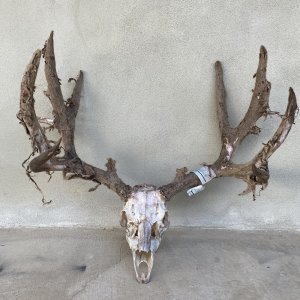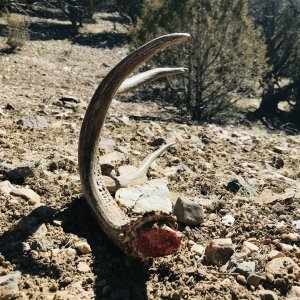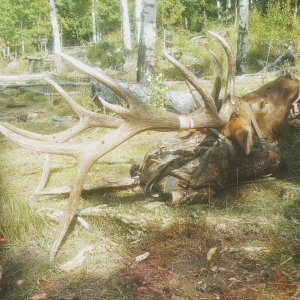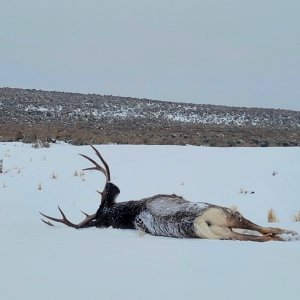eelgrass
Long Time Member
- Messages
- 31,437
Web posted Wednesday, July 4, 2007
King for a day
Angler lands 88-pound salmon
WILL MORROW
Peninsula Clarion

--------------------------------------------------------------------------------
Photo by Will Morrow Pete Baldwin of Scottsdale, Ariz., holds up the trophy Kenai River king salmon, estimated at 88 pounds, he caught while fishing with guide Joe Dilley of Joe's Guide Service. The fish measured 56 inches in length and 32 inches in girth.
Photo by Will Morrow
--------------------------------------------------------------------------------
Pete Baldwin has a lot of experience fishing and hunting, but Tuesday's king salmon trip on the Kenai River is one he'll remember for the rest of his life.
"I had just put my line in the water and sat down," said Baldwin, 38, of Scottsdale, Ariz. "I looked at my rod, and the tip was already in the water. I pulled it out of the holder and set the hook, and I knew I had something huge."
Baldwin said it took about 20 minutes to get the fish to the boat ? where he realized just how big the salmon was.
"We didn't see it until we could get it up close to the boat," Baldwin said.
The king turned out to be a beauty ? bright silver, 56 inches long and 32 inches in girth. Guide Joe Dilley, of Joe's Guide Service, estimated the weight to be 88 pounds based on guidelines from the Alaska Department of Fish and Game.
Dilley said the fish would be taken to the Fish and Game offices to be sealed ? a procedure required for Kenai River kings 55 inches or longer.
Baldwin was fishing with his father, Dennis, and several other friends and their fathers. Dennis Baldwin said his son bought the trip as a Father's Day present, and it was his just reward to catch such a nice fish.
"This is his first trip to Alaska. He's turned down several trips because he's a workaholic," Pete said.
Pete said his father taught him to fish for rainbow and cutthroat trout and Dolly Varden in Montana's backcountry while he was growing up there.
"But I never taught him to catch the biggest fish," Dennis said.
Dennis did catch the first fish of the day, around 8 a.m. Pete said they started fishing at 6:01 a.m., and was just getting ready to pour a second cup of coffee following his dad's catch when his rod tip doubled over, around 8:40 a.m.
The fish made several runs up and downstream, and at one point swam under the boat. Even at 6-foot-4 and 230 pounds, Pete said the king wore him out.
"I was completely out of breath," Pete said of the fight. "Afterward, it was a complete adrenaline rush. ... We were shaking for about 45 minutes afterward."
Dennis caught the battle on videotape ? and did his best to stay out of the way.
"It was pandemonium on the boat," Pete said.
Pete said he plans to have his trophy king mounted and will hang it in his log home in Flagstaff.
The Baldwins started their Alaska adventure with a fly-out trip to Wolverine Creek on the west side of Cook Inlet and some fishing on the upper Kenai River. They'll spend another day fishing for kings on the lower river before heading to Seward to try their luck in saltwater.
"It's a heck of a trip he bought me," Dennis said.
Dilley said he was walking on water after a great day fishing.
"Every fish that comes in is awesome," said Dilley. "I love it. I was ecstatic myself. Every one is like the first."
Any Kenai River king salmon 55 inches or longer must be sealed by Alaska Department of Fish and Game staff within three days of harvest. Fish and Game offices are located at 43961 Kalifornsky Beach Road in Soldotna.
When sealing a fish, Fish and Game staff typically measure weight and girth, as well as the distance from the fish's eye to the fork in its tail. Samples of the fish's scales are used to determine the time the fish has spent in freshwater and saltwater, and Fish and Game records the fish's color. A genetic sample also is taken, and the fish is given a seal number
The king salmon record is 97 pounds, 4 ounces, caught by Les Anderson in 1985. On the Kenai River, king salmon bigger than 75 pounds are considered trophy-sized.
King for a day
Angler lands 88-pound salmon
WILL MORROW
Peninsula Clarion

--------------------------------------------------------------------------------
Photo by Will Morrow Pete Baldwin of Scottsdale, Ariz., holds up the trophy Kenai River king salmon, estimated at 88 pounds, he caught while fishing with guide Joe Dilley of Joe's Guide Service. The fish measured 56 inches in length and 32 inches in girth.
Photo by Will Morrow
--------------------------------------------------------------------------------
Pete Baldwin has a lot of experience fishing and hunting, but Tuesday's king salmon trip on the Kenai River is one he'll remember for the rest of his life.
"I had just put my line in the water and sat down," said Baldwin, 38, of Scottsdale, Ariz. "I looked at my rod, and the tip was already in the water. I pulled it out of the holder and set the hook, and I knew I had something huge."
Baldwin said it took about 20 minutes to get the fish to the boat ? where he realized just how big the salmon was.
"We didn't see it until we could get it up close to the boat," Baldwin said.
The king turned out to be a beauty ? bright silver, 56 inches long and 32 inches in girth. Guide Joe Dilley, of Joe's Guide Service, estimated the weight to be 88 pounds based on guidelines from the Alaska Department of Fish and Game.
Dilley said the fish would be taken to the Fish and Game offices to be sealed ? a procedure required for Kenai River kings 55 inches or longer.
Baldwin was fishing with his father, Dennis, and several other friends and their fathers. Dennis Baldwin said his son bought the trip as a Father's Day present, and it was his just reward to catch such a nice fish.
"This is his first trip to Alaska. He's turned down several trips because he's a workaholic," Pete said.
Pete said his father taught him to fish for rainbow and cutthroat trout and Dolly Varden in Montana's backcountry while he was growing up there.
"But I never taught him to catch the biggest fish," Dennis said.
Dennis did catch the first fish of the day, around 8 a.m. Pete said they started fishing at 6:01 a.m., and was just getting ready to pour a second cup of coffee following his dad's catch when his rod tip doubled over, around 8:40 a.m.
The fish made several runs up and downstream, and at one point swam under the boat. Even at 6-foot-4 and 230 pounds, Pete said the king wore him out.
"I was completely out of breath," Pete said of the fight. "Afterward, it was a complete adrenaline rush. ... We were shaking for about 45 minutes afterward."
Dennis caught the battle on videotape ? and did his best to stay out of the way.
"It was pandemonium on the boat," Pete said.
Pete said he plans to have his trophy king mounted and will hang it in his log home in Flagstaff.
The Baldwins started their Alaska adventure with a fly-out trip to Wolverine Creek on the west side of Cook Inlet and some fishing on the upper Kenai River. They'll spend another day fishing for kings on the lower river before heading to Seward to try their luck in saltwater.
"It's a heck of a trip he bought me," Dennis said.
Dilley said he was walking on water after a great day fishing.
"Every fish that comes in is awesome," said Dilley. "I love it. I was ecstatic myself. Every one is like the first."
Any Kenai River king salmon 55 inches or longer must be sealed by Alaska Department of Fish and Game staff within three days of harvest. Fish and Game offices are located at 43961 Kalifornsky Beach Road in Soldotna.
When sealing a fish, Fish and Game staff typically measure weight and girth, as well as the distance from the fish's eye to the fork in its tail. Samples of the fish's scales are used to determine the time the fish has spent in freshwater and saltwater, and Fish and Game records the fish's color. A genetic sample also is taken, and the fish is given a seal number
The king salmon record is 97 pounds, 4 ounces, caught by Les Anderson in 1985. On the Kenai River, king salmon bigger than 75 pounds are considered trophy-sized.












